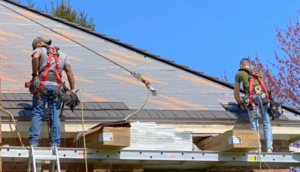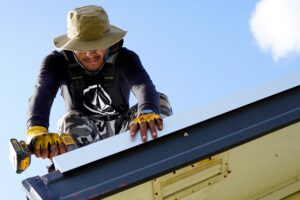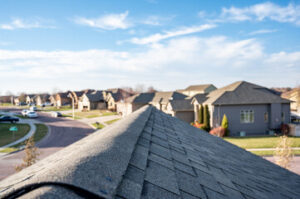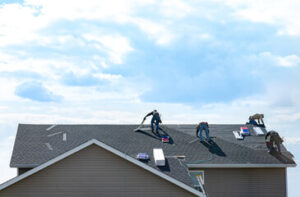Columbus Roof Repair is a great way to improve your home’s appearance and increase its value. It can also reduce maintenance costs, protect the home from water damage, and lower energy bills.
Many people may assume that a damaged roof needs to be replaced. Still, a professional restoration can revitalize the roof and push back the need for repairs or replacement over the years. It is also a more sustainable option, preventing roofing waste from ending in landfills.
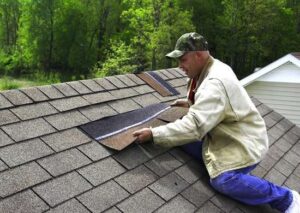
Roof restoration is a great alternative to replacing your roof. It costs around half as much, saving you tens of thousands of dollars in the long run. In addition, you can use the money saved to make other repairs or upgrades to your home. Roof restoration can also be done quickly and efficiently. In most cases, an experienced crew can restore a roof in about ten business days.
The cost-effectiveness of roof restoration varies according to the extent of the damage. Whether the roof is old and worn or has been damaged by hail or debris, a professional roofing adviser will help you decide the best option for your roof.
Typically, roof restoration involves:
- Replacing and re-aligning broken tiles.
- Repairing cracked or broken tile sheets.
- Repointing the ridge edges.
This will ensure your roof is water-tight and leak-free for years to come. It can add up to 15 years to the life of your roof. It is also cheaper than replacement and is more environmentally friendly because the roof’s materials are reused.
Additionally, roof restoration can improve your home’s resale value. Potential buyers will be more interested in buying a property in good condition.
Roof restoration can improve your roof’s energy efficiency, significantly reducing electricity bills. A poorly maintained roof can allow warm air to escape during winter, forcing you to crank up the heating or AC. The thermal properties of a well-restored roof can keep you comfortable and reduce your energy bills.
If you are thinking about re-roofing, it is important to find a licensed builder who can provide quality artistry. All states have licensing bodies that maintain a register of licensed builders. Ask the builder to see their credentials and a portfolio of previous work. Also, ask them about their warranty terms and conditions. If they offer a long-term guarantee, it is usually a sign of a high-quality job. Moreover, the building company should be insured to cover any damages caused by their work. This way, you can rest assured that your investment is safe.
A well-maintained roof will not only keep the interior of your home safe and protected, but it will also add value to your property. This is why it is important to take the time to repair and restore your roof when necessary. While this process may last less time than a new roof, it is still more affordable than replacing your roof and will provide you with many years of protection from the elements. However, if your roof is already showing signs of deterioration, a replacement may be the best option for you.
During a roof restoration, a professional roofer will clean your existing roof and apply a protective coating to protect it from further damage. They will also repair any leaks and replace broken tiles. Moreover, roof restoration will improve the appearance of your roof, making it look like new.
While the longevity of a restored roof will vary depending on the conditions it is exposed to, the average restoration will last anywhere from 10 to 15 years. This is a great option for homeowners who want to avoid investing in a costly roof replacement but also want to avoid paying for repairs.
The longevity of a roof can be further improved by installing a reflective coating. This will help reduce the heat your roof absorbs, lowering energy bills. In addition, these coatings can help protect the surface from cracking and fading over time.
Another benefit of roof restoration is that it can add curb appeal to your home or business. It can even increase the value of your property and lead to a faster sale if you decide to sell your home or business. If you are interested in learning more about the benefits of roof restoration, contact Longevity Roofing and Restoration today.
Roof restoration is a more cost-effective alternative to re-roofing and will usually last for the same lifespan as a new roof. It is ideal to perform a roof restoration before major problems occur. Ideally, this should be done before any leaking starts or there is evidence of moisture in the interior of your property, such as dark spots on the ceiling or rot or mold.
A roof is not just a protective barrier against weather elements; it contributes to a building’s aesthetics and architectural integrity. Whether it’s the sleek lines of a modern home, the rustic charm of a cottage, or the timeless elegance of a historic landmark, a well-designed roof enhances its visual appeal and entices people to engage with the property. This aesthetic appeal is crucial not only for personal satisfaction but also in terms of resale value and energy efficiency.
While a roof can be repaired to address minor aesthetic issues, structural damage may require replacement. For example, if water stains or leaks appear on the ceiling or walls, the roof is likely discolored or weakened. In addition, roofs with significant deterioration are more susceptible to damage from wind, hail, and storms. Roof restoration offers a comprehensive solution that addresses multiple issues and provides a more effective protective layer against the elements.
Additionally, roof restoration minimizes waste. While replacing a roof requires the production and disposal of a whole new structure, restoring an existing one reduces environmental impact and cost. In the case of historical or heritage buildings, retaining a restored original roof is important for maintaining its aesthetic and architectural integrity.
Moreover, roof restoration can improve the visual appeal of a home by rejuvenating its appearance and boosting curb appeal. The process involves cleaning the roof, repairing it, and adding coatings that help prevent future deterioration. It’s worth noting that some community guidelines and homeowner association regulations require specific aesthetic standards for roofs within a neighborhood. This is done to ensure consistent, attractive roofs and protect the value of the properties. A restored roof can add a great deal of aesthetic appeal to a home, making it more appealing to potential buyers and increasing its resale value.
Roof restoration is a good way to extend the life of your existing roofing. It’s cost-efficient and less invasive than a re-roofing project, and it can even add up to 10 years to your roof’s lifespan. However, there are some things you need to consider before deciding on the right type of roof restoration for your home. For example, you should consider the resale value of your property and how important it is to keep your home safe from harsh weather elements and falling debris.
Before a roof restoration, a thorough roof inspection should be conducted to identify any problems. Then, the damaged areas will be repaired to prepare them for a coating restoration. In addition, a full roof cleaning is usually included in the quote to remove dirt, grit, moss, and mold from the surface of your roof. This helps ensure that the new coating will adhere properly and protect your roof from the elements for as long as possible.
While roof repair is necessary, it can be hazardous when it is done incorrectly. There are several safety hazards to be aware of, including electrical dangers and the proximity of power lines to the roof. Wearing personal protective equipment (PPE) and avoiding overhead power lines can help prevent injuries. In addition, ladders should be secured properly, and workers should be aware of any nearby hazards.
When choosing a roof restoration company, it is important to choose a licensed and registered builder. Each state has a building regulator or authority that maintains a list of licensed builders. It is also a good idea to check the company’s insurance coverage before hiring them for a job. This will protect you if something goes wrong during a project. It is also a good idea to look for references from previous clients. In general, if a building company provides you with references, they are likely to be reliable and professional. If the company does not provide you with references, it is best to look elsewhere.
